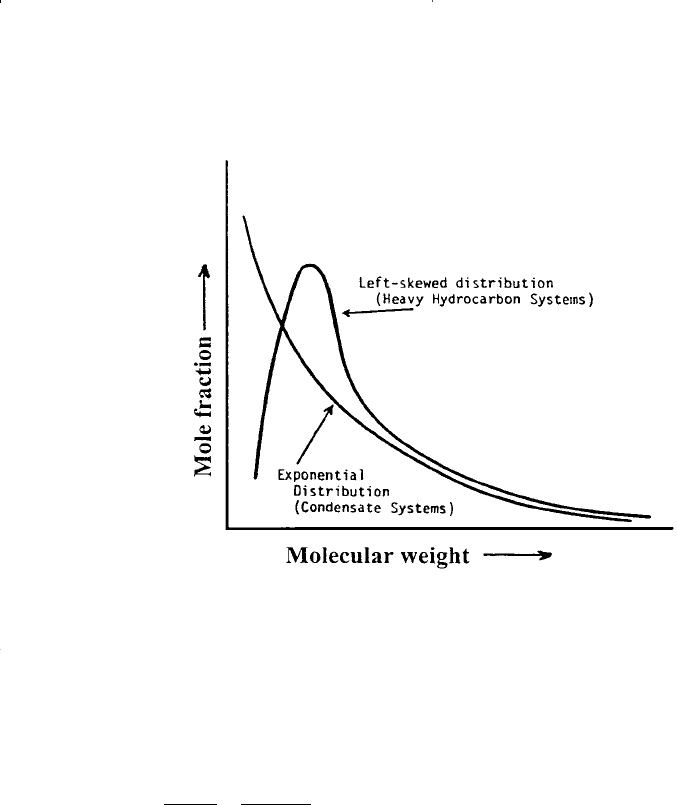Tarek Ahmed. Reservoir engineering handbook
Подождите немного. Документ загружается.


phase behavior calculations. Numerous authors have indicated that these
errors can be substantially reduced by “splitting” or “breaking down” the
plus fraction into a manageable number of fractions (pseudo-components)
for equation of state calculations.
The problem, then, is how to adequately split a C
7+
fraction into a
number of psuedo-components characterized by:
• Mole fractions
• Molecular weights
• Specific gravities
These characterization properties, when properly M
7+
combined, should
match the measured plus fraction properties, i.e., (M)
7+
and (γ)
7+
.
Splitting Schemes
Splitting schemes refer to the procedures of dividing the heptanes-plus
fraction into hydrocarbon groups with a single carbon number (C
7
, C
8
,
C
9
, etc.) and are described by the same physical properties used for pure
components.
Several authors have proposed different schemes for extending the
molar distribution behavior of C
7+
, i.e., the molecular weight and specific
gravity. In general, the proposed schemes are based on the observation
that lighter systems such as condensates usually exhibit exponential
molar distribution, while heavier systems often show left-skewed distri-
butions. This behavior is shown schematically in Figure 15-15.
Three important requirements should be satisfied when applying any
of the proposed splitting models:
1. The sum of the mole fractions of the individual pseudo-components is
equal to the mole fraction of C
7+
.
2. The sum of the products of the mole fraction and the molecular
weight of the individual pseudo-components is equal to the product of
the mole fraction and molecular weight of C
7+
.
3. The sum of the product of the mole fraction and molecular weight
divided by the specific gravity of each individual component is equal
to that of C
7+
.
The above requirements can be expressed mathematically by the follow-
ing relationship:
1138 Reservoir Engineering Handbook
Reservoir Eng Hndbk Ch 15 2001-10-25 17:41 Page 1138

Figure 15-15. Exponential and left-skewed distribution functions.
where z
7+
= mole fraction of C
7+
n = number of carbon atoms
N
+
= last hydrocarbon group in C
7+
with n carbon atoms, e.g.,
20+
z
n
= mole fraction of psuedo-component with n carbon
atoms
M
7+
, γ
7+
= measure of molecular weight and specific gravity of C
7+
M
n
, γ
n
= Molecular weight and specific gravity of the psuedo-
component with n carbon atoms
Several splitting schemes have been proposed recently. These schemes,
as discussed below, are used to predict the compositional distribution of
the heavy plus fraction.
zz
zM z M
zM z M
n
n
N
nn
n
N
nn
n
n
N
=
+
+
=
+
++
=
+
++
+
∑
∑
∑
=
(
)
[]
=
(
)
=
(
)
7
7
7
77
7
77
7
15 -169
15 -170
15 -171
γγ
Vapor–Liquid Phase Equilibria 1139
Reservoir Eng Hndbk Ch 15 2001-10-25 17:41 Page 1139

Katz’s Method
Katz (1983) presented an easy-to-use graphical correlation for break-
ing down into pseudo-components the C
7+
fraction present in condensate
systems. The method was originated by studying the compositional
behavior of six condensate systems using detailed extended analysis. On
a semi-log scale, the mole percent of each constituent of the C
7+
fraction
versus the carbon number in the fraction was plotted. The resulting rela-
tionship can be conveniently expressed mathematically by the following
expression:
where z
7+
= mole fracture of C
7+
in the condensate system
n = number of carbon atoms of the psuedo-component
z
n
= mole fraction of the pseudo-component with number of
carbon atoms of n
Equation 15-172 is repeatedly applied until Equation 15-169 is satisfied.
The molecular weight and specific gravity of the last pseudo-component
can be calculated from Equations 15-170 and 15-171, respectively.
The computational procedure of Katz’s method is best explained
through the following example.
Example 15-17
A naturally occurring condensate gas system has the following compo-
sition:
Component z
i
C
1
0.9135
C
2
0.0403
C
3
0.0153
i – C
4
0.0039
n – C
4
0.0043
i – C
5
0.0015
n – C
5
0.0019
C
6
0.0039
C
7+
0.0154
zze
n
n
=
(
)
+
−
1 38205
7
0 25903
.
.
15 -172
1140 Reservoir Engineering Handbook
Reservoir Eng Hndbk Ch 15 2001-10-25 17:41 Page 1140

The molecular weight and specific gravity of C
7+
are 141.25 and 0.797,
respectively.
a. Using Katz’s splitting scheme, extend the compositional distribution
of C
7+
to the pseudo-fraction C
16+
.
b. Calculate M, γ, T
b
, p
c
, T
c
, and ω of C
16+
.
Solution
a. Applying Equation 15-172 with z
7+
= 0.0154 gives
n Experimental z
n
Equation 15-172 z
n
7 0.00361 0.00347
8 0.00285 0.00268
9 0.00222 0.00207
10 0.00158 0.001596
11 0.00121 0.00123
12 0.00097 0.00095
13 0.00083 0.00073
14 0.00069 0.000566
15 0.00050 0.000437
16+ 0.00094 0.001671*
*
This value is obtained by applying Equations 15-169, i.e.,
b.
Step 1. Calculate the molecular weight and specific gravity of C
16+
by
solving Equations 15-170 and 15-171 for these properties:
and
where M
n
, γ
n
= molecular weight and specific gravity of the
hydrocarbon group with n carbon atoms. The calculations are
performed in the following tabulated form:
γ
γγ
16
16 16
77 7
7
15
+
++
+++
=
=
(
)
−
∑
zM
zM
zM
nn
n
n
/
MzM
z
zM
nn
n
16 7 7
16
7
15
1
+++
+
=
=−
⋅
(
)
∑
0 0154 0 001671
7
15
...−=
=
∑
z
n
n
Vapor–Liquid Phase Equilibria 1141
Reservoir Eng Hndbk Ch 15 2001-10-25 17:41 Page 1141

M
n
n
nz
n
(Table 1-1) z
n
M
n
(Table 1-1) z
n
· M/
n
7 0.00347 96 0.33312 0.727 0.4582
8 0.00268 107 0.28676 0.749 0.3829
9 0.00207 121 0.25047 0.768 0.3261
10 0.001596 134 0.213864 0.782 0.27348
11 0.00123 147 0.18081 0.793 0.22801
12 0.00095 161 0.15295 0.804 0.19024
13 0.00073 175 0.12775 0.815 0.15675
14 0.000566 190 0.10754 0.826 0.13019
15 0.000437 206 0.09002 0.836 0.10768
16+ 0.001671 — — — —
1.743284 2.25355
Step 2. Calculate the boiling points, critical pressure, and critical tem-
perature of C
16+
by using the Riazi–Daubert correlation to
give:
T
b
= 1,136°R
p
c
= 215 psia
T
c
= 1,473°R
Step 3. Calculate the acentric factor of C
16+
by applying the Edmister
correlation to give ω = 0.684.
Lohrenz’s Method
Lohrenz et al. (1964) proposed that the heptanes-plus fraction could be
divided into pseudo-components with carbon numbers ranging from 7 to
40. They mathematically stated that the mole fraction z
n
is related to its
number of carbon atoms n and the mole fraction of the hexane fraction z
6
by the expression:
zze
n
An Bn
=
(
)
−
()
+−
()
6
66
2
15 -173
M
16
16
0 0154 141 25 1 743284
0 001671
258 5
0 001671 258 5
0 0154 141 25
0 797
2 25355 0 908
+
+
=
(
)
(
)
−
=
=
(
)
(
)
(
)
(
)
(
)
−=
...
.
.
..
..
.
..γ
1142 Reservoir Engineering Handbook
Reservoir Eng Hndbk Ch 15 2001-10-25 17:41 Page 1142

The constants A and B are determined such that the constraints given by
Equations 15-169 through 15-171 are satisfied.
The use of Equation 15-173 assumes that the individual C
7+
compo-
nents are distributed through the hexane mole fraction and tail off to an
extremely small quantity of heavy hydrocarbons.
Example 15-18
Rework Example 15-17 by using the Lohrenz splitting scheme and
assuming that a partial molar distribution of C
7+
is available. The compo-
sition is given below:
Component z
i
C
1
0.9135
C
2
0.0403
C
3
0.0153
i – C
4
0.0039
n – C
4
0.0043
i – C
5
0.0015
n – C
5
0.0019
C
6
0.0039
C
7
0.00361
C
8
0.00285
C
9
0.00222
C
10
0.00158
C
11+
0.00514
Solution
Step 1. Determine the coefficients A and B of Equation 15-173 by the
least-squares fit to the mole fractions C
6
through C
10
to give A =
0.03453 and B = 0.08777.
Step 2. Solve for the mole fraction of C
10
through C
15
by applying Equa-
tion 15-173 and setting z
6
= 0.0039:
Vapor–Liquid Phase Equilibria 1143
Reservoir Eng Hndbk Ch 15 2001-10-25 17:41 Page 1143

Component Experimental z
n
Equation 15-173 z
n
C
7
0.00361 0.00361
C
8
0.00285 0.00285
C
9
0.00222 0.00222
C
10
0.00158 0.00158
C
11
0.00121 0.00106
C
12
0.00097 0.00066
C
13
0.00083 0.00039
C
14
0.00069 0.00021
C
15
0.00050 0.00011
C
16+
0.00094 0.00271*
*Obtained by applying Equation 15-169.
Step 3. Calculate the molecular weight and specific gravity of C
16+
by
applying Equations 15-170 and 15-171 to give (M)
16+
= 233.3
and (γ)
16+
= 0.943.
Step 4. Solve for T
b
, p
c
, T
c
, and ω by applying the Riazi–Daubert and
Edmister correlations, to give:
T
b
= 1,103°R
p
c
= 251 psia
T
c
= 1,467°R
ω = 0.600
Pedersen’s Method
Pedersen et al. (1982) proposed that, for naturally occurring hydrocar-
bon mixtures, an exponential relationship exists between the mole frac-
tion of a component and the corresponding carbon number. They
expressed this relationship mathematically in the following form:
where A and B are constants.
For condensates and volatile oils, P
edersen and coworkers suggested
that A and B can be determined by a least-squares fit to the molar distribu-
tion of the lighter fractions. Equation 15-174 can then be used to calculate
ze
n
nA B
=
(
)
−
()
/
15 -174
1144 Reservoir Engineering Handbook
Reservoir Eng Hndbk Ch 15 2001-10-25 17:41 Page 1144

the molar content of each of the heavier fractions by extrapolation. The
classical constraints as given by Equations 15-169 through 15-171 are also
imposed.
Example 15-19
Rework Example 15-18 using the Pedersen splitting correlation.
Solution
Step 1. Calculate coefficients A and B by the least-squares fit to the
molar distribution of C
6
through C
10
to give A = –14.404639 and
B = –3.8125739.
Step 2. Solve for the mole fraction of C
10
through C
15
by applying Equa-
tion 15-176.
Component Experimental z
n
Calculated z
n
C
7
0.000361 0.00361
C
8
0.00285 0.00285
C
9
0.00222 0.00222
C
10
0.00158 0.00166
C
11
0.00121 0.00128
C
12
0.00097 0.00098
C
13
0.00083 0.00076
C
14
0.00069 0.00058
C
15
0.00050 0.00045
C
16+
0.00094 0.00101*
*From Equation 15-169.
Ahmed’s Method
Ahmed et al. (1985) devised a simplified method for splitting the C
7+
fraction into pseudo-components. The method originated from studying
the molar behavior of 34 condensate and crude oil systems through
detailed laboratory compositional analysis of the heavy fractions. The
only required data for the proposed method are the molecular weight and
the total mole fraction of the heptanes-plus fraction.
The splitting scheme is based on calculating the mole fraction z
n
at a
progressively higher number of carbon atoms. The extraction process
Vapor–Liquid Phase Equilibria 1145
Reservoir Eng Hndbk Ch 15 2001-10-25 17:41 Page 1145

continues until the sum of the mole fraction of the pseudo-components
equals the total mole fraction of the heptanes-plus (z
7+
).
where z
n
= mole fraction of the pseudo-component with a number of
carbon atoms of n (z
7
, z
8
, z
9
, etc.)
M
n
= molecular weight of the hydrocarbon group with n carbon
atoms as given in Table 1-1 in Chapter 1
M
n+
= molecular weight of the n+ fraction as calculated by the
following expression:
where n is the number of carbon atoms and S is the coefficient of
Equation 15-178 with these values:
Number of Carbon Atoms Condensate Systems Crude Oil Systems
n ≤ 8 15.5 16.5
n > 8 17.0 20.1
The stepwise calculation sequences of the proposed correlation are
summarized in the following steps:
Step 1. According to the type of hydrocarbon system under investigation
(condensate or crude oil), select appropriate values for the coeffi-
cients.
Step 2. Knowing the molecular weight of C
7+
fraction (M
7+
), calculate
the molecular weight of the octanes-plus fraction (M
8+
) by apply-
ing Equation 15-176.
Step 3. Calculate the mole fraction of the heptane fraction (z
7
) using
Equation 15-175.
Step 4. Apply steps 2 and 3 repeatedly for each component in the system
(C
8
, C
9
, etc.) until the sum of the calculated mole fractions is
equal to the mole fraction of C
7+
of the system.
MMSn
n +
()
+
+
=+−
(
)
(
)
1
7
6 15 -176
zz
MM
MM
nn
n
n
n
n
=
−
−
(
)
+
+
()
+
+
+
()
+
1
1
15 -175
1146 Reservoir Engineering Handbook
Reservoir Eng Hndbk Ch 15 2001-10-25 17:41 Page 1146

The splitting scheme is best explained through the following example.
Example 15-20
Rework Example 15-19 using Ahmed’s splitting method.
Solution
Step 1. Calculate the molecular weight of C
8+
by applying Equation 15-176:
Step 2. Solve for the mole fraction of heptane (z
7
) by applying Equation
15-175:
Step 3. Calculate the molecular weight of C
9+
from Equation 15-178:
Step 4. Determine the mole fraction of C
8
from Equation 15-177:
Step 5. This extracting method is repeated as outlined in the above steps
to give:
M
n
+
M
n
z
n
Component n Equation 15-176 (Table 1-1) Equation 15-175
C
7
7 141.25 96 0.000393
C
8
8 156.25 107 0.00276
C
9
9 175.25 121 0.00200
C
10
10 192.25 134 0.00144
C
11
11 209.25 147 0.00106
C
12
12 226.25 161 0.0008
C
13
13 243.25 175 0.00061
C
14
14 260.25 190 0.00048
C
15
15 277.25 206 0.00038
C
16+
16+ 294.25 222 0.00159*
*Calculated from Equation 15-169.
zzMM MM
z
8898 98
8
0 0154 0 00393 172 5 156 75 172 5 107
0 00276
=−
(
)
−
(
)
[]
=−
(
)
−
(
)
−
(
)
[]
=
++ + +
/
.. ../.
.
M
9
141 25 15 5 8 6 172 25
+
=+−
(
)
=.. .
zz
MM
MM
77
87
87
0 0154
156 75 141 25
156 75 96
0 00393=
−
−
=
−
−
=
+
++
+
.
..
.
.
M
8
141 25 15 5 7 6 156 75
+
=+−
(
)
=.. .
Vapor–Liquid Phase Equilibria 1147
Reservoir Eng Hndbk Ch 15 2001-10-25 17:41 Page 1147
